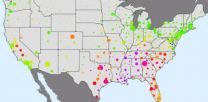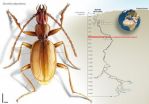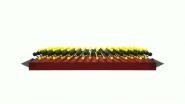(Press-News.org) The most detailed analysis to date of the spread of the H1N1 2009 pandemic influenza virus, known informally as 'swine flu', has found that short-range travel was likely the primary driver for the 2009 pandemic in the United States, in contrast with popularly accepted views on the way diseases spread.
The study, based on data gathered from health insurance claims made throughout 2009, found that international air travel, which was previously thought to be important in the pandemic, played only a minor role in its spread within the US.
A team of researchers from University of Cambridge and the US, including Princeton University and National Institutes of Health, analysed data from 271 American cities and their surrounding suburban areas, covering 90% of the population of the 48 contiguous states.
The data were used to test mathematical models to pinpoint the role and importance of factors associated with H1N1's arrival and spread, including demographics, school opening dates, humidity levels and immunity from previous outbreaks.
According to this new analysis, school-age children accelerated the spread of the pandemic, which was transmitted over short distances, in contrast with widespread reports at the time linking the pandemic to international air travel and population density. The results are published in the journal PLOS Computational Biology.
The H1N1 influenza virus spread rapidly around the globe in 2009 after it was first identified in Mexico. The US Centers for Disease Control (CDC) estimates that the global death toll from the 2009 pandemic was more than 284,000.
The virus hit the United States in two distinct waves during 2009: one in the spring, which was limited mainly to the North Eastern part of the country; and a second wave in the autumn, which started in the South Eastern US and gradually spread across the whole country over a period of three months.
Previous research on the pandemic found that environmental factors, timing of the end school holidays, population sizes and air travel contributed to its spread, but this new research has found that transmission occurred primarily over short distances and that school age children may have catalysed the spread.
"There is so little detailed analysis of the way in which pandemics spread – so much of the current thinking is based on opinion and presumption," said Dr Julia Gog of Cambridge's Department of Applied Mathematics and Theoretical Physics, who led the research. "We have a view of how diseases spread in the medieval times, and it is often said that the modern world is completely different as we have long distance high volume air travel. However what we find here is that although air travel must have caused the initial 'sparks,' the bulk of the pandemic wave was very slow, travelling at about 22 kilometres per day. This really challenges our views of modern pandemics."
In collaboration with researchers from a number of American universities, Dr Gog analysed weekly numbers of patients who reported influenza-like illnesses to their physician, organised by zip code. The data enable the researchers to explore the pandemic's spread in more detail than had previously been possible, as well as identify any gaps in the data and validate existing models.
"It's remarkable that in an era of widespread air travel and regional ground transport that this pandemic spread so slowly," said Dr Gog. While international air travel did play a role in the initial seeding of the outbreaks in spring 2009, it played a relatively minor role in the later spread. The researchers hypothesise that H1N1's relatively low rate of transmission meant that in many cases, the virus failed to 'take' after being introduced to a community through air travel. In contrast, repeated transmission over short distances started chains of infection which then contributed to the overall spatial spread of the pandemic.
The travel patterns of children also appear to have played an important role. While one might assume that the movements of children would primarily be between home and school, there is little available information to confirm this. "This is just not studied," said Dr Gog. "Especially in densely populated areas, any parent will tell you that their child travels over relatively short distances each day, but we simply don't have the data to back that up."
In addition to broadening understanding the dynamics of a pandemic, the researchers hope that the potential role of children in influenza spread might lead to more information on this age group's role in infection transmission.
INFORMATION:
For more information, contact:
Sarah Collins
Office of Communications, University of Cambridge
Tel: +44 (0)1223 332300 Mob: +44 (0)7525 337458
sarah.collins@admin.cam.ac.uk
Notes to editors:
The paper "Spatial transmission of 2009 pandemic influenza in the US" is published in the journal PLOS Computational Biology: http://www.ploscompbiol.org/article/info%3Adoi%2F10.1371%2Fjournal.pcbi.1003635
New analysis of 'swine flu' pandemic conflicts with accepted views on how diseases spread
2014-07-01
ELSE PRESS RELEASES FROM THIS DATE:
Cancer risk: Aspirin and smoking affect aging of genes
2014-07-01
The risk of developing cancer increases with age. Factors like smoking and regular aspirin use also affect the risk of cancer – although in the opposite sense. Researchers from the University of Basel were now able to show that aspirin use and smoking both influence aging processes of the female genome that are connected to colorectal cancer. The Journal of the National Cancer Institute has published their results.
Already in the 1990s, scientists discovered that regular use of aspirin over long periods of time decreases the cancer risk. Since then, numerous studies have ...
Analysis of the Chinese facial profile: Contours of the side face in the Tu & Zang ethnic minorities
2014-07-01
Li Haijun and fellow researchers at Minzu University of China, in Beijing, conducted a series of geometric morphometric analyses of the contours of the side face and variations in the Tu and Zang (Tibetan) ethnic minorities from Qinghai Province, in northwestern China.
Their study, entitled "Morphometric analysis of the Chinese facial profile: Contours of the side face and variations in the Tu and Zang ethnic minorities", was published (in Chinese) in the Chinese Science Bulletin, 2014, Vol 59(16).
The team of researchers used advanced digital cameras and image processing ...
A Spaniard and a Portuguese discover a new species of beetle in the world's deepest cave
2014-07-01
The unusual habitat of the Krubera cave in the Western Caucasus remains a mystery. Researchers from two Spanish universities have discovered a new species of beetle in the depths of this cave.
Cave beetles are one of the most iconic species found in subterranean habitats. They were historically the first living organisms described by science that are adapted to the conditions of hypogean or subterranean life.
Now, a Portuguese scientist and a Spaniard have discovered a new species of beetle in the deepest cave known to man; a cave 2,140 metres deep. It is the Krubera ...
Scientists uncover the key to adaptation limits of ocean dwellers
2014-07-01
The simpler, the more heat-resistant – scientists uncover the key to adaptation limits of ocean dwellers
Bremerhaven, Germany, 1 July 2014. The simpler a marine organism is structured, the better it is suited for survival during climate change. Scientists of the Alfred Wegener Institute, Helmholtz Centre for Polar and Marine Research discovered this in a new meta-study, which appears today in the research journal Global Change Biology. For the first time biologists studied the relationship between the complexity of life forms and the ultimate limits of their adaptation ...
The biology of addiction risk looks like addiction
2014-07-01
Philadelphia, PA, July 1, 2014 – Research suggests that people at increased risk for developing addiction share many of the same neurobiological signatures of people who have already developed addiction. This similarity is to be expected, as individuals with family members who have struggled with addiction are over-represented in the population of addicted people.
However, a generation of animal research supports the hypothesis that the addiction process changes the brain in ways that converge with the distinctive neurobiology of the heritable risk for addiction. In other ...
In study of individual neuron activity, key brain region responds to subjective perception
2014-07-01
LOS ANGELES (June 30, 2014) – When evaluating another person's emotions – happy, sad, angry, afraid – humans take cues from facial expressions. Neurons in a part of the brain called the amygdala "fire" in response to the visual stimulation as information is processed by the retina, the amygdala and a network of interconnected brain structures. Some of these regions respond just to the actual features of the face, whereas others respond to how things appear to the viewer, but it is unknown where in the brain this difference arises.
Although the amygdala's importance in ...
Up in flames: Evidence confirms combustion theory
2014-07-01
Researchers at the Department of Energy's Lawrence Berkeley National Lab (Berkeley Lab) and the University of Hawaii have uncovered the first step in the process that transforms gas-phase molecules into solid particles like soot and other carbon-based compounds.
The finding could help combustion chemists make more-efficient, less-polluting fuels and help materials scientists fine-tune their carbon nanotubes and graphene sheets for faster, smaller electronics. In addition, the results could have implications for the burgeoning field of astrochemistry, potentially establishing ...
Study finds online bullying creates off-line fear at school
2014-07-01
HUNTSVILLE, TX (7/1/14) -- Cyberbullying creates fear among students about being victimized at school, a recent study by Sam Houston State University found.
While traditional bullying still creates the most fear among students, cyberbullying is a significant factor for fear of victimization at school among students who have experienced bullying or disorder At school, such as the presence of gangs. The fear from cyberbullying is most prominent in minority populations.
"It cannot be overstated – online victimization has offline consequences, and those consequences may ...
Scientists discover how plastic solar panels work
2014-07-01
This news release is available in French.
Scientists don't fully understand how 'plastic' solar panels work, which complicates the improvement of their cost efficiency, thereby blocking the wider use of the technology. However, researchers at the University of Montreal, the Science and Technology Facilities Council, Imperial College London and the University of Cyprus have determined how light beams excite the chemicals in solar panels, enabling them to produce charge. "Our findings are of key importance for a fundamental mechanistic understanding, with molecular ...
Stanford engineers envision an electronic switch just 3 atoms thick
2014-07-01
VIDEO:
This animation shows the three-atom thick crystal being pulled from a non-conductive to conductive state, and then being pushed back to the non-conductive state.
Click here for more information.
Do not fold, spindle or mutilate. Those instructions were once printed on punch cards that fed data to mainframe computers. Today's smart phones process more data, but they still weren't built for being shoved into back pockets.
In the quest to build gadgets that can survive such ...






